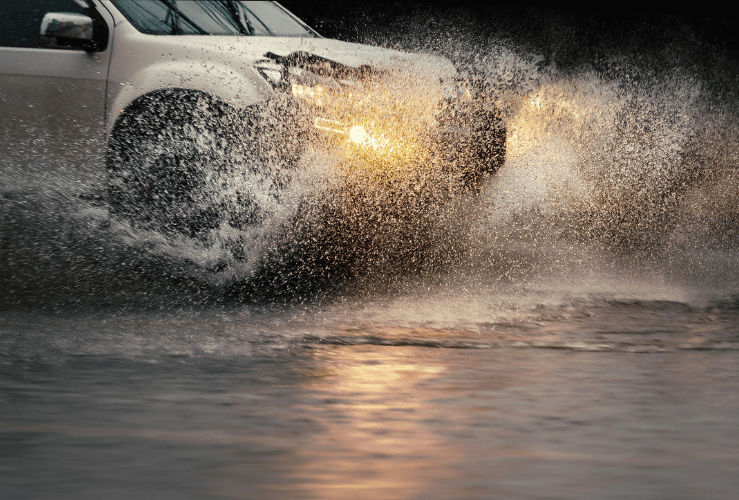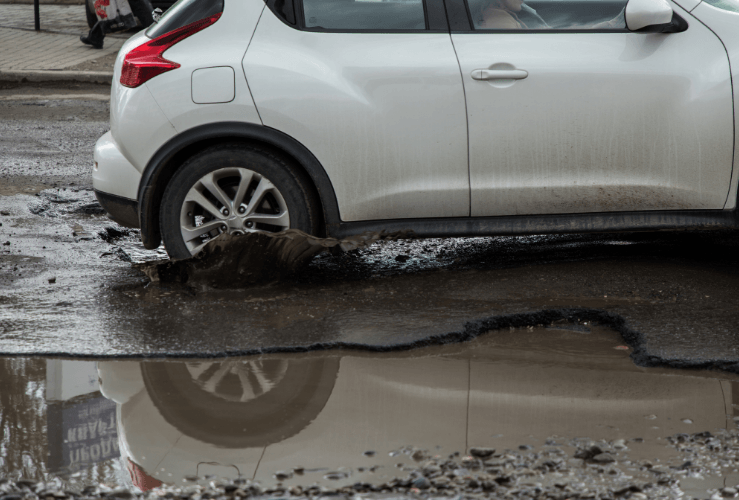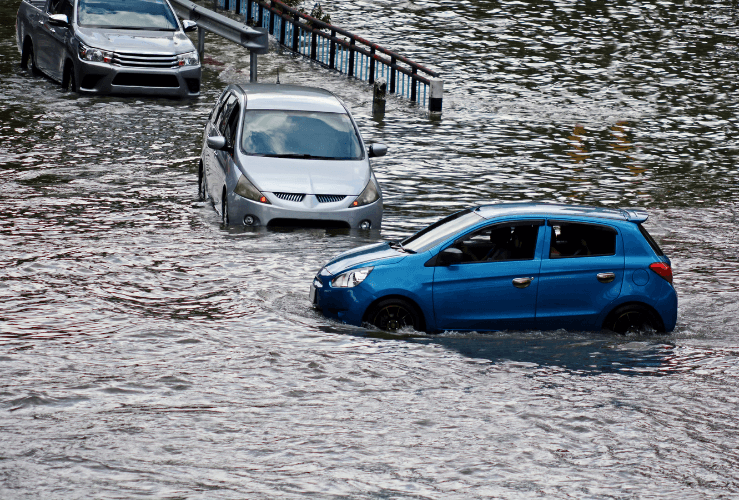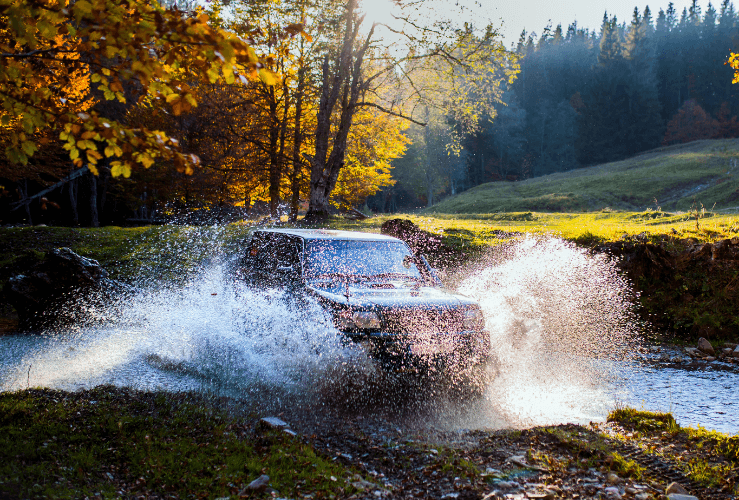Driving through flood water could cause costly or even irreparable damage to your vehicle, so avoid it if you can.
However, there may be rare occasions when you are compelled to drive through a volume of water. If you're in this position, then this guide on how to drive through flood water is for you.

Air intakes: Why does my car need oxygen anyway?
Your vehicle's engine is constantly sucking in air, compressing it, mixing it with petrol or diesel, and then combusting it to pump the pistons.
Why does water cause so much damage to the engine?
Air can be compressed, but water cannot. So when your engine sucks in water and attempts to compress it, the rod that holds the piston in place can get bent, which can strike parts of the engine, and essentially blow holes in it.
 Even driving in fairly shallow water can be risky
Even driving in fairly shallow water can be risky
A water level that reaches halfway up your tyre may not seem especially risky, but it can be - particularly when you consider the waves that can be created, pushing water up higher.
Where is the air intake on your vehicle?
It is critical to locate your air intake before attempting to drive through flood water.
Air intakes located lower down will of course allow water into the vehicle more easily.
Only consider driving through flood water if you believe the water will not reach the air intake.
If you can, turn around the way you came, or aim for higher ground.
Premium cars often have air intakes further down, making flood driving more risky.
Flood driving: The risk of losing control of your vehicle
Aside from engine damage, moving through flood water might also cause you to lose control of your vehicle. Just six inches of water can make it more difficult to control your car.

How many inches of water can float a car?
One foot of water (12 inches) can make some vehicles float. Two feet of water can carry away most cars.
If you have a smaller car, it’s best to avoid entering water over four inches (10cm).
You don’t know what is under the water
Bear in mind you have no idea what obstacles lie beneath the water, so drive through flood water with caution.
From gutters to rocks to other debris shifted by the flood water, all manner of objects could impede your route.
If it is safe and shallow enough to do so, you may consider walking along the route you propose to take, so you have a better idea of ‘what lies beneath’.
Drive through flood water in first gear
Stay in first gear when driving through flood water. This is necessary due to the high level of resistance posed by the water.
Don't take your foot off the accelerator pedal
Keep on revving steadily as you move through the water. Keep your speed low.
If you're driving a manual transmission, press the clutch down slightly as you press the accelerator - which should reduce the chances of a stalling (as will staying in first gear) and help keep water out of the exhaust pipe.
Don't dash into the water
If you enter flood water at speed, you will increase the chances of water splashing into your air intake, so move into the water slowly.
If your car stops, do not restart it
If your vehicle stalls for any reason when you are attempting to drive through flood water, do not try to restart the engine, because this will suck water into your engine, probably causing irreparable damage.
Unless it is safe and practical to push your vehicle out of the water, contact your breakdown recovery provider, who will be able to arrange a tow.
Don't have breakdown recovery in place? You can get a quote online from Start Rescue.
What to do after driving through water?
If you manage to exit the water on your own, stop for a while to let any excess water drain away.
If you’ve been rescued by your recovery service, they will be able to advise on what to do next, but you should probably take it to a mechanic for a full inspection.

Driving through water with a four wheel drive
Some off-road/four wheel drive vehicles are designed to deal with flood water better, but you still need to exercise caution.
It's important to understand the weighting depth of your vehicle, so you don't risk flooding the engine.
In general, off-roaders like Defenders and Range Rovers have their air intakes higher up, so the risk of engine flooding is reduced. However, use the applicable sensor/technology - such as 'wade sensing' on a Defender - to see if the water level is too high.
Before entering the water, let your engine and transmission cool down. Ideally, you should attach a tow rope, too - but this isn’t always possible or practical.
You might also consider letting some air out of the tyres, and coating the engine’s electrical components with a water-resistant spray. And as an extra precaution, wind down your window - in case you need to make a hasty exit.
Stay in first or second gear and, with regular cars, keep the throttle steady. Aim to create a bow wave in front of your vehicle in order to prevent water entering the engine bay.
Once you're out of the water, stop and let any excess water drain away. Depress the brakes a few times to dry them out.
If you get stuck, keep the engine running and call for assistance. If you've attached a tow rope this should be easier.
Water on the road: If you see a 'road closed' sign
If you see a road closed sign during or after heavy rainfall, it is highly advisable that you turn back and postpone your journey. If you do not, you could be putting yourself and your passengers at risk, and potentially creating additional work for the rescue services - who may already be overstretched in bad weather.
Will insurance cover driving through water?
Most comprehensive car insurance policies will provide cover for accidental damage caused by driving through flood water. However, if they feel the driver was being reckless by driving through flood water, they may decide not to pay out.
Flooded car: How to dry out a wet vehicle
While your engine may have survived entering floodwater, the interior of your car may not have come away unscathed. As such, it's important to get air into your wet car. This will help prevent mildew, mould and unpleasant odours.
Choose a covered, secure parking space, then open all the windows. You might hook up an electric fan and direct it to badly affected areas to help speed up the process.
Can you save a flooded car?
It may be possible to save a flooded car (that has been retrieved to dry land). As mentioned, do not start the engine, as this could cause permanent damage.
You need to ascertain if the engine transmission was flooded with water.
Note: A professional car mechanic will have the knowledge and experience to potentially salvage a car with a flooded engine. However, those with mechanical experience may wish to attempt the job.
Oil dipstick
First, check the oil dipstick. If it is clean to the full line, it suggests no water got inside. If it's clean beyond the full line, this suggests water got in and displaced the oil.
If water did get in the engine, it's possible to drain and change the oil and filter - in which case the engine may be salvageable.
Transmission fluid
You should also check the transmission fluid; check to see if the reservoir flooded with water.
If it has, it can be drained - and the engine could be saved.
Air filter
In addition, check the air filter; if it's dripping with water, you know water has got inside the engine.
If water is present, you need to take out the spark plugs to prevent pressure build-up when you start the engine; water will spurt out of the spark plug holes when you do so. You would then replace the spark plugs once all the water is gone.
Can I drive my electric car through flood water?
Electric cars are a different kettle of fish to combustion engine cars. For a start, they do not require air to function, so there are no air intakes to worry about. Indeed, EVs are designed to be safe to drive through water. However, driving through salt water could increase the risk of a short circuit, so it is best avoided.
If an EV has been standing in flood water
All that said, if an EV has been standing in water for a long period, you should watch for signs of fire.
Note that the EV’s high voltage battery is isolated from the car chassis, so the electrocution risk is low.
It is not possible for the battery to electrify the water around the vehicle, but if you see bubbles, move away, because toxic gases may be escaping. The manufacturer will be able to provide advice on this topic.
A final note
Remember, avoid driving through flood water if you can, especially if it is over 10cm/4inches. And if your car stalls while in water, do not restart it, as this could cause permanent damage that will essentially write off your vehicle.




